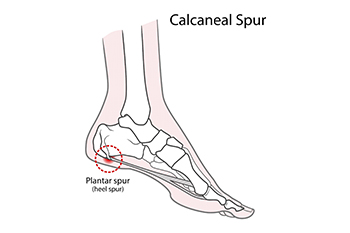
What are Heel Spurs?
Heel Spurs are boney protrusions that develop on the bottom edge of the heel bone when it sustains repeated stress and the body sends calcium to the area in response. This extra calcium builds up over time to form sharp outgrowths on the bone that can sometimes reach 1/2” in length.
What Causes Heel Spurs?
Heel spurs are caused by damage or bruising to the heel bone. They are commonly caused by plantar fasciitis, and both conditions can occur at the same time.
Plantar fasciitis is a condition where the plantar fascia tissue that runs along the bottom of the foot, connecting the heels with the toes, becomes overly stretched, worn down, or torn. This causes repeated irritation on the heel bone where the tissue inserts and triggers the body’s attempt to heal by releasing calcium to the site. The heel spur begins to develop over months or even years.
Heel Spur Symptoms
Heel spurs are often asymptomatic and are only discovered on an X-ray. If they are symptomatic, they can cause intermittent or chronic pain, inflammation, and tenderness at the bottom of the heel.
Heel Spur Risk Factors
The following are factors and situations that may increase the risk of plantar fasciitis and heel spurs developing:
- Obesity or sudden weight gain, which puts undue stress on the plantar fascia and heel
- Having to stand at work all day
- Ill-fitting, unsupportive footwear that puts strain on the arch and alters one’s gait
- Repetitive movements or high-impact physical activity (like running on hard surfaces) that overly stretches or wears down the plantar fascia tissue
- Age, which can make the plantar fascia less flexible and thin down the heel’s fat pad
- Diabetes, which can cause hyperglycemia, weight gain, and weaken or thicken the plantar fascia
- High Arches or Flat Feet
Treatment of Heel Spurs
A podiatrist may use one or more of the following measures to help treat heel spurs:
Resting and Icing: If heel spurs are symptomatic, a podiatrist may use icing to reduce pain and inflammation. They may also recommend refraining from physical activities that attributed to the formation of the heel spurs and resting the feet throughout the day.
Proper Footwear & Orthotics: Podiatrists can make professional recommendations on footwear to help relieve symptoms. They may also prescribe custom-designed and fitted orthotics which can relieve pressure from the heel spur and support the arch.
Physical Therapy: Certain exercises, physical therapy, lower leg strengthening, and massage can also help reduce the pain and inflammation of heel spurs, while increasing mobility and flexibility.
Taping & Night Splints: Techniques such as arch support taping or night splints can often help heal the plantar fascia and reduce symptoms of heel pain and plantar fasciitis.
Medications: A podiatrist may recommend over-the-counter oral medications and/or corticosteroid injections to reduce pain and inflammation.
Surgery: If conservative measures fail to provide relief after approximately one year, your podiatrist may recommend surgery to remove the heel spur and treat the plantar fasciitis that may have contributed to its formation.
If you believe you may have a heel spur, make an appointment with a podiatrist to have your condition properly diagnosed and treated.
